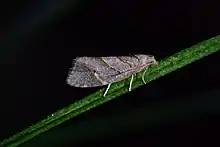Ecclitica torogramma
Ecclitica torogramma, also known as the ponga ugly nestmaker,[3] is a species of moth of the family Tortricidae.[1] It is endemic to New Zealand.
| Ecclitica torogramma | |
|---|---|
 | |
| Scientific classification | |
| Kingdom: | |
| Phylum: | |
| Class: | |
| Order: | |
| Family: | |
| Genus: | |
| Species: | E. torogramma |
| Binomial name | |
| Ecclitica torogramma | |
| Synonyms[2] | |
| |
Taxonomy
This species was first described by Edward Meyrick in 1897 using specimens collected by George Hudson in Wellington and named Cacoecia torogramma.[2][4]
Description
.jpg.webp)
The larva is small and green with a brown head and when mature is under 10 mm in length.[3]
Meyrick described the adult female of this species as follows:
♂♀ 19 mm. Head and thorax whitish-ochreous, slightly reddish-tinged. Palpi moderately long. Antennal ciliations in ♂ 1. Forewings suboblong, costa rather strongly arched, termen sinuate, rather oblique, costal fold in ♂ short, basal ; whitish-ochreous, reddish-tinged, or mixed with pale reddish and whitish ; outer edge of basal patch straight, very oblique, dark fuscous or red-brown ; central fascia evenly broad, straight, very oblique, edged with dark fuscous or red-brown streaks, posterior not reaching tornus, in ♀ followed by a wedge-shaped whitish costal spot reaching half across wing, dark-edged posteriorly. Hindwings whitish-fuscous, rather darker in ♀.[4]
Distribution
This species is endemic to New Zealand and is found throughout the North Island and in the northern parts of the South Island.[5][6]
Habitat and hosts
This species inhabits native forest.[6] Its larval host plant is the silver fern.[6]
Behaviour
The larvae create a nest for themselves by weaving the growing tips of the fronds of its host plant together with silk webbing.[3] They consume these fronds during spring and summer.[3] Adults of this species are on the wing from September to February. Adults are nocturnal although they can sometimes be seen flying during the day when disturbed. They are attracted to light.[6] The adult moths can often be located during the day, hiding on the underside of fronds of their host plant.[3]
References
- Gordon, Dennis P., ed. (2010). New Zealand inventory of biodiversity: Kingdom animalia : chaetognatha, ecdysozoa, ichnofossils. Vol. 2. p. 464. ISBN 978-1-877257-93-3. OCLC 973607714. OL 25288394M. Wikidata Q45922947.
- John Stewart Dugdale (23 September 1988). "Lepidoptera - annotated catalogue, and keys to family-group taxa". Fauna of New Zealand. Department of Scientific and Industrial Research. 14: 121–122. doi:10.7931/J2/FNZ.14. ISSN 0111-5383. Wikidata Q45083134.
- Andrew Crowe (2004). Life-Size Guide to New Zealand Native Ferns: Featuring the unique caterpillars which feed on them. p. 26. ISBN 0-14-301924-4. Wikidata Q115211440.
- Edward Meyrick (16 December 1897). "XVI. Descriptions of New Lepidoptera from Australia and New Zealand". Transactions of the Royal Entomological Society of London. 45 (4): 388–389. doi:10.1111/J.1365-2311.1897.TB00976.X. ISSN 0035-8894. Wikidata Q56158835.
- "Ecclitica torogramma (Meyrick, 1897)". www.nzor.org.nz. Retrieved 2022-06-01.
- Hoare, Robert J. B. (2014). A photographic guide to moths & butterflies of New Zealand. Olivier Ball. Auckland. p. 48. ISBN 978-1-86966-399-5. OCLC 891672034.
{{cite book}}: CS1 maint: date and year (link) CS1 maint: location missing publisher (link)